
Atlas F1 Contributing Writer
From its early days, the Silverstone circuit has been the venue of historical moments, and after more than 50 years it's still regarded as one of the legendary Grand Prix tracks. The British circuit has also been subject to several changes to its face as it tries to adapt to the current requirements. Journalist and historian Doug Nye reviews those changes and looks back at the history of the British Grand Prix
Normally up here - on what was once Luffield Abbey Farm - there's a constant breeze, sometimes quite robust, sweeping across the exposed fields which still neighbour the British Racing Drivers' Club's prized property, rattling and clattering at their acres of grandstands. More often there's cloud above and the wind is cold, niggling at spectator, track official, and car and driver alike. And regularly there's rain in that wind, drenching the track, sometimes flooding it - most notoriously, perhaps, just wetting the surface treacherously as a fleeting, aggravating, race-wrecking shower.
Silverstone was first used for the British Royal Automobile Club's Grand Prix in 1948. An initial hour-glass shaped course combining former aerodrome perimeter track and infield runways was soon forgotten in favour of the classical perimeter-track only course which remained in use throughout the major part of the 1950s, throughout the '60s and '70s and into the 1980s.
While the original start and pit area was adjacent to the old farm buildings, between the present Abbey corner and Bridge, it was moved for 1952 to its long-time and present site between Woodcote and Copse Corners. Into the later 1970s Woodcote Corner itself became one of the racing world's longest-surviving high-speed corners, which was a sad commentary upon the way racing was developing since at best the Silverstone circuit of the '50s and '60s had been regarded as being medium-fast, at best.
In the 1963 British Grand Prix meeting, RAC scrutineer Harry Cree was struck and killed against the entirely unprotected pit counter by a small GT car which had spun at well over 100mph while exiting Woodcote Corner. Another driver had also been killed in such a collision, while sitting in his sports car, stationary in that pit lane. To prevent any repetition, a raised pit-lane was built, accessed by ramp at the Woodcote end, with its trackside wall protecting the new pit line.
It worked well, and through the later '60s and '70s Woodcote Corner really came into its own as a spectacular place to watch Formula One's contemporary finest really on the absolute edge, at 150mph and above.
Britain's own Reg Parnell was flagged off the winner, at the wheel of Tony Vandervell's 'ThinWall Special' Ferrari. It was billed as Alfa Romeo's first postwar defeat. Nobody really believed it, least of all Reg Parnell and Tony Vandervell. Both were realistic enough to know that what had really dented Alfa's record was the British weather, not them, nor their rival Italian car.
Close races at Silverstone saw Woodcote Corner feature large in their dramatic story - not least in the non-Championship BRDC International Trophy of 1962, when Jimmy Clark and Graham Hill drifted their Lotus and BRM V8s respectively, absolutely flat-strap across the finish line - with Graham's teetering BRM 'Old Faithful' just taking the win by mere inches on the timing line.
In 1964, corresponding race, corresponding corner, history repeated itself - but this time the players were Jack Brabham in his Brabham-Climax and Graham in a monocoque BRM - the latest P261 V8. Graham led into Woodcote, 'Black Jack' appeared not so much to brake, as simply to toss his car sideways on the outside, and this time Graham and the BRM were defeated - a fantastic win for the great Australian.
And of course there were other times and other sights to savour - Jim Clark swishing out of Woodcote, lap after late-race lap, with his engine dead, silent, then slipping-in the clutch to revive it to raucous life. Low on oil, surge in that high-speed right-handed sweep had been zeroing the engine oil pressure - so to conserve his power unit JC had resorted to switching off and coasting through the most threatening corner, but also one of the fastest, through which he would lose the least time. And he won - as he did here so many times.
In 1965 - another International Trophy - a newcomer to the ranks of Formula One race winners - Jackie Stewart in BRM P261. Come 1969 and he and his great friend and rival Jochen Rindt would fight a tremendous battle in the British Grand Prix here - JYS in Tyrrell-entered Matra, Jochen in Team Lotus 49B…which the Scot would win.
The Grand Prix at that time was alternating year-on, year-off, with Brands Hatch in Kent. By the time the British Grand Prix returned to Silverstone in 1975 the mighty heart-in-mouth sweep of 'the old' Woodcote had been replaced by a lazy yet still pace-killing chicane. The old pit-line had been bulldozed, and the first of Silverstone's bewildering subsequent series of 'state-of-the-art facilities' had been erected in its place.
Yet still the wacky races syndrome stuck like glue to the BRDC's home. Violent rain showers swept the circuit in the Grand Prix's later stages. Trapped on slick tyres most of the field slithered into one huge unholy Formula One scrapyard amongst the catch-fencing at Club Corner. Only six drivers took the chequered flag and Emerson Fittipaldi - who had been driving like an accountant all year for McLaren - took the win…
In 1976 James Hunt won the International Trophy to commence his World Championship season in Britain, and in '77 Silverstone's spectator areas erupted again in glee as reigning World Champion James Hunt won again for McLaren, after John Watson had dominated for 50 laps in Bernie Ecclestone's Brabham-Alfa Romeo flat-12. Fuel pick-up then engine problems had sidelined the popular Ulsterman.
The 1978 International Trophy was another rain-drowned race - superstars flurried off on standing water in the opening stages - but a new boy's fantastic car control was demonstrated to the full as Keke Rosberg won…in Teddy Yip's completely unfancied outsider entry, the Theodore-Cosworth. Wacky races with knobs on…
Non-Championship Formula One races had been squeezed out of the calendar. Back at Silverstone in 1981 the British GP produced another stunningly popular 'home' winner - 'Wattie' himself, victorious for the revamped McLaren International team's first time, Ron Dennis, John Barnard and the Woking team were launched on their fantastic record-breaking roll.
It was Silverstone's turn to host the Grand Prix again in 1983 - Prost boring as ever, winning for Renault after the rousing new Ferraris had led 20 laps until their tyres 'went off'.
Ayrton Senna made his mark for Lotus at Silverstone in 1985 - leading for 57 straight laps until an over-rich fuel control drained his car's tanks…and Prost inherited victory for McLaren.
Nigel Mansell fought his classic internecine Williams-Honda battle with teammate Nelson Piquet at Silverstone '87 - the Brazilian driving non-stop, Nigel forced to change tyres, rejoining and driving absolutely like a man possessed - as indeed he was - and selling that famous 'dummy' on the entry to Stowe Corner to lead the final three laps - then run out of fuel on his victory lap.
In 1994 during the aftermath of poor Senna's death at Imola, enormous changes were made to Silverstone which finally punched it beyond recognition for most old-stagers and lifelong supporters of a certain age. A slower infield loop section was introduced before Woodcote and the Becketts Corner section which had once been the slowest corner on the entire track became the modern sweeping ess-bend. Pedro Lamy's frightening testing crash in a Lotus before Bridge had been the trigger for much of this wholesale transformation, for the wreck of his car had hurdled the pre-existing debris fencing and had ended-up in the entrance to an under-track spectator tunnel. The consequences of such a flightpath on a raceday were unthinkable.
In 1995 both Stowe and Club Corners were reprofiled, barely a year was passing without some fundamental change alternately screwing-up and improving Silverstone from both the drivers' and spectators' viewpoint while year-on-year lap times lost any comparative significance whatsoever. The latest configuration seems a workable compromise of the truly awful and the relatively awesome…but trudge around the outfield and narrow your eyes and recall the old photographs and movie and TV footage and recall what once has been…and there, still, is the spark of a wonderful sporting stage, and still one with much - so very much - to offer.
Silverstone can be a glorious, evocative, roasting place in high summer when the air is still and the sky is cloudless and the sun beats mercilessly down upon this one-time wartime military aerodrome. That doesn't seem to happen, as the locals in Northamptonshire might say, "right often".
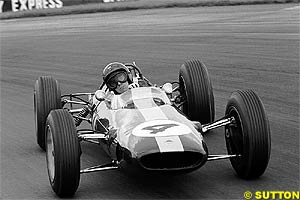 Silverstone is a circuit site which drips with Formula One racing history, but in recent times the circuit itself has undergone such enormous, repeated, often knee-jerk, mindless change that any parity with what once lay here - the stage upon which so many all-time great drivers and supreme Grand Prix cars did their stuff - that there's precious little left for the confirmed nostalgist to savour misty-eyed - nor for the motor racing statistician to enjoy as a straight comparator between times then, and times now…
Silverstone is a circuit site which drips with Formula One racing history, but in recent times the circuit itself has undergone such enormous, repeated, often knee-jerk, mindless change that any parity with what once lay here - the stage upon which so many all-time great drivers and supreme Grand Prix cars did their stuff - that there's precious little left for the confirmed nostalgist to savour misty-eyed - nor for the motor racing statistician to enjoy as a straight comparator between times then, and times now…
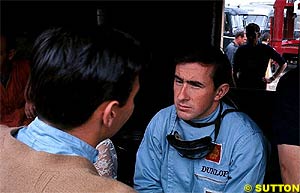 Now Silverstone had long been developing a reputation as being a venue on which wacky races tended to be run. An early BRDC International Trophy had been assailed by such a violent rainstorm that the circuit drains were rapidly overwhelmed and acres of standing water absolutely inundated the lower-lying areas of former per-track and runway. The otherwise absolutely dominant, unbeatable supercharged Alfettas run by the Italian factory's Alfa Corse team literally drowned in the downpour - their supercharger intakes gulping in huge volumes of water.
Now Silverstone had long been developing a reputation as being a venue on which wacky races tended to be run. An early BRDC International Trophy had been assailed by such a violent rainstorm that the circuit drains were rapidly overwhelmed and acres of standing water absolutely inundated the lower-lying areas of former per-track and runway. The otherwise absolutely dominant, unbeatable supercharged Alfettas run by the Italian factory's Alfa Corse team literally drowned in the downpour - their supercharger intakes gulping in huge volumes of water.
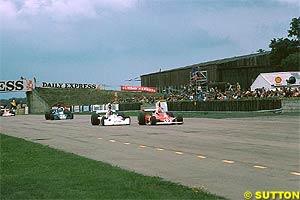 But then in 1973 Woodcote bit the British Grand Prix field. New boy Jody Scheckter ran over an oil slick dropped on the starting grid, and careened into the pit-ramp wall in his Yardley-McLaren M23. The closely-bunched pack stood little chance - an horrendous multiple collision erupting between grandstands and pits which developed into a boiling cloud of tyre smoke and steam, laced with flying, bouncing fragments of high-tech Formula One car. Amazingly only one driver, Andrea de Adamich of Brabham, suffered any substantial injuries, and the race was restarted with a decimated field of surviving runners. John Young Stewart won once more.
But then in 1973 Woodcote bit the British Grand Prix field. New boy Jody Scheckter ran over an oil slick dropped on the starting grid, and careened into the pit-ramp wall in his Yardley-McLaren M23. The closely-bunched pack stood little chance - an horrendous multiple collision erupting between grandstands and pits which developed into a boiling cloud of tyre smoke and steam, laced with flying, bouncing fragments of high-tech Formula One car. Amazingly only one driver, Andrea de Adamich of Brabham, suffered any substantial injuries, and the race was restarted with a decimated field of surviving runners. John Young Stewart won once more.
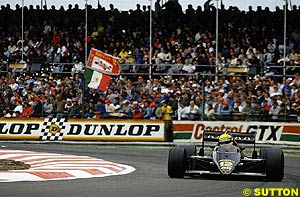 We went to Silverstone in '79 eager to see a maiden Grande Epreuve win for Frank Williams and Patrick Head - their number one star Alan Jones led most of the way, but when his Williams FW07 failed, team-mate Clay Regazzoni brought home the trophy. For all that evening, far into the night - the rugged Swiss was an honourary Brit, they loved him…and the newly emergent Didcot team.
We went to Silverstone in '79 eager to see a maiden Grande Epreuve win for Frank Williams and Patrick Head - their number one star Alan Jones led most of the way, but when his Williams FW07 failed, team-mate Clay Regazzoni brought home the trophy. For all that evening, far into the night - the rugged Swiss was an honourary Brit, they loved him…and the newly emergent Didcot team.
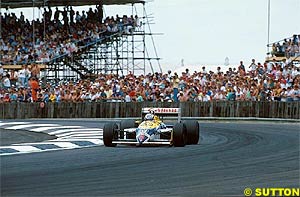 And then Silverstone became the Grand Prix's annual home from 1988 and we are within range of most current fans' memory. In 1989 a tight chicane was introduced before Woodcote, and in 1992 the section between Stowe and Club Corners was completely re-worked to provide "a more interesting section of track in front of the newly installed spectators' viewing banks".
And then Silverstone became the Grand Prix's annual home from 1988 and we are within range of most current fans' memory. In 1989 a tight chicane was introduced before Woodcote, and in 1992 the section between Stowe and Club Corners was completely re-worked to provide "a more interesting section of track in front of the newly installed spectators' viewing banks".
Please Contact Us for permission to republish this or any other material from Atlas F1.
|
Volume 8, Issue 27
Atlas F1 Exclusive
Interview with Guenther Steiner
Jo Ramirez: a Racing Man
Articles
Trust and Trulli
British GP Preview
British GP Preview
Local History: British GP
Facts, Stats & Memoirs
Columns
British GP Quiz
Bookworm Critique
Elsewhere in Racing
The Grapevine
> Homepage |